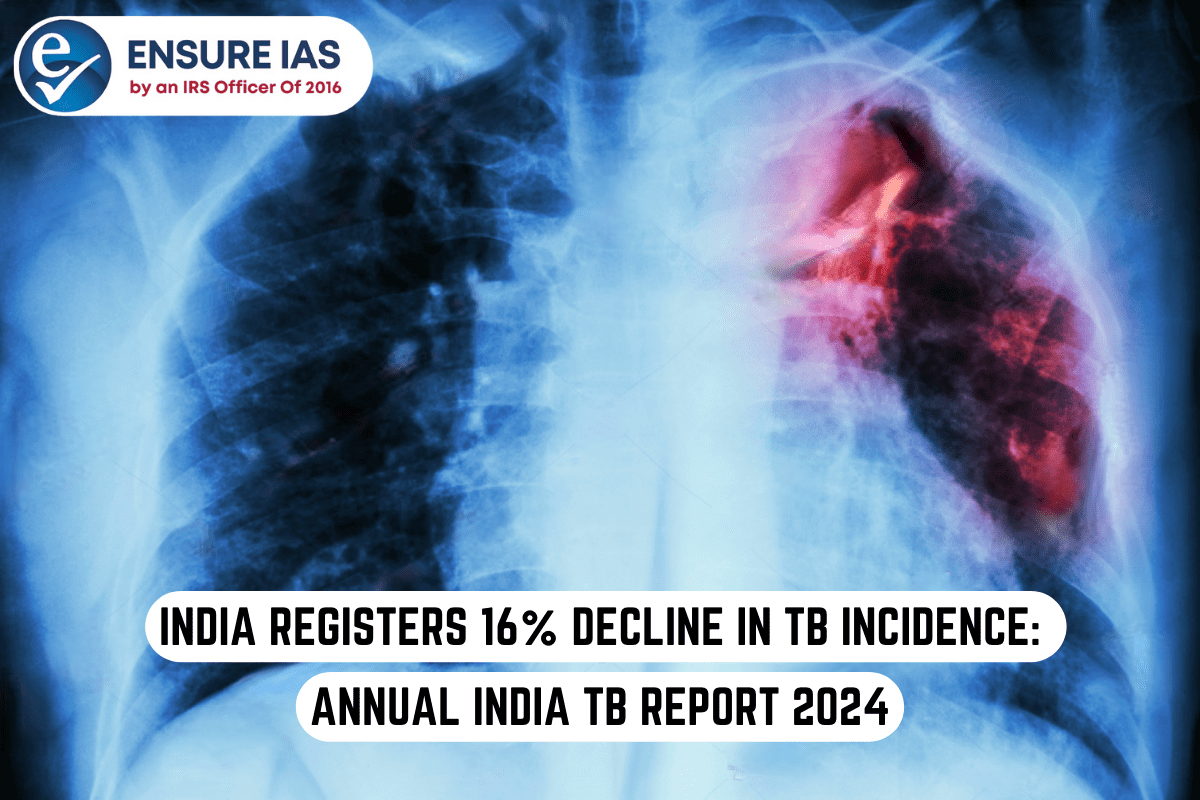- Courses
- GS Full Course 1 Year
- GS Full Course 2 Year
- GS Full Course 3 Year
- GS Full Course Till Selection
- Answer Alpha: Mains 2025 Mentorship
- MEP (Mains Enrichment Programme) Data, Facts
- Essay Target – 150+ Marks
- Online Program
- GS Recorded Course
- Polity
- Geography
- Economy
- Ancient, Medieval and Art & Culture AMAC
- Modern India, Post Independence & World History
- Environment
- Governance
- Science & Technology
- International Relations and Internal Security
- Disaster Management
- Ethics
- NCERT Current Affairs
- Indian Society and Social Issue
- NCERT- Science and Technology
- NCERT - Geography
- NCERT - Ancient History
- NCERT- World History
- NCERT Modern History
- CSAT
- 5 LAYERED ARJUNA Mentorship
- Public Administration Optional
- ABOUT US
- OUR TOPPERS
- TEST SERIES
- FREE STUDY MATERIAL
- VIDEOS
- CONTACT US
ANNUAL INDIA TB REPORT 2024
ANNUAL INDIA TB REPORT 2024
30-03-2024

India has achieved a significant 16% decline in tuberculosis (TB) incidence from 2015 to 2022, surpassing the global decline of 9%. The National TB Elimination Programme, India TB Report 2024, reveals that 25.55 lakh cases of TB were notified last year, representing the highest number of cases since the launch of the National Tuberculosis Elimination Programme (NTEP) in the 1960s.
State-wise Notifications:
- Uttar Pradesh recorded the highest number of TB case notifications compared to the previous year.
- Bihar was the second-highest state in terms of TB case notifications.
- Over 8.4 lakh cases were from the private sector.
- There was a 1.17% increase in TB case notifications from the private sector compared to 2022.
Treatment Coverage and Mortality:
- India's treatment coverage improved to 80% of the estimated TB cases.
- This represents a 19% increase over the previous year.
- TB mortality was 23 per lakh population.
- This is an 18% decline compared to 2015, when it was 28 per lakh population.
Achievements and Milestones:
- India achieved a rate of approximately 179 cases per lakh population in 2023.
- The programme diagnosed 63,939 cases of multidrug-resistant TB (MDR-TB), highlighting its commitment to addressing drug resistance.
- In 2023, more than 20.5 crore individuals were screened for signs and symptoms suggestive of TB as part of active case-finding efforts.
- Out of the total TB cases notified in 2023, 60.7% were men, 39.2% women, and 0.04% transgender.
About TB:
- Tuberculosis (TB) is an infectious disease caused by the bacteria Mycobacterium tuberculosis. It mainly affects the lungs but can affect other parts of the body as well.
- TB spreads through the air when an infected person coughs, sneezes or speaks.
- Common symptoms include a persistent cough, fever, night sweats, and weight loss.
- Diagnosis includes chest X-ray, sputum test, and skin test.
- Treatment usually involves a combination of antibiotics taken for several months.
- TB remains a major global health problem, especially in developing countries.
Types of TB
There are two main types of tuberculosis (TB)
Latent TB:
|
Active TB:
|
Additionally, there are other forms of TB:Miliary TB:
Drug-resistant TB:
|
TB-HIV Co-infection:
- Globally, especially in India, TB and HIV are two major public health problems.
- People living with HIV have a 20 times higher risk of developing active TB than people without HIV infection.
- In 2023, the total number of TB-HIV co-infected cases was 34,476.
National TB Elimination Programme:
The National TB Elimination Program (NTEP), previously known as the Revised National Tuberculosis Control Program (RNTCP), was launched in 1997 and has since made significant progress in reducing the burden of TB in India. Its main features are:
- DOTS Strategy: The Directly Observed Treatment, Short-course strategy is the core of the program, ensuring proper diagnosis, treatment, and monitoring of TB patients.
- Free Diagnosis and Treatment: The program provides free diagnostic services and anti-TB drugs to all patients seeking treatment in the public health system.
- Public-Private Partnerships: The program collaborates with private healthcare providers to expand access to TB care and enhance case notification.
- Active Case Finding: The program conducts door-to-door screening in high-risk areas to identify and treat TB cases early.
- Nikshay: A web-based platform for case-based monitoring and management of TB patients.
- National Strategic Plan (NSP) for TB Elimination 2017-2025: The NSP outlines the interventions and strategies to achieve the goal of ending TB in India by 2025. This is five years ahead of the global target.
|
The 2023 Global Tuberculosis (TB) report from the World Health Organization (WHO) has several highlights, including:
- India:
- India has seen a 16% reduction in TB incidence since 2015, and TB mortality has decreased by 18%.
- India has also seen a 19% increase in TB treatment coverage, and is one of only four countries among the 30 highest-burden countries in the world that has achieved more than 80% treatment coverage.
- India has also set a target of eliminating TB in the country by 2025.
- Global TB incidence: The TB incidence rate (new cases per 100,000 population per year) rose by 3.9% between 2020 and 2022, reversing declines of about 2% per year for most of the past two decades.
- TB diagnosis and treatment: The report shows that there has been a significant recovery in the scale-up of TB diagnosis and treatment services in 2022.
- TB mortality: The mortality of TB has also reduced by 18% during the same period in India and globally. The WHO has made a downward revision of the TB mortality rates from 4.94 lakhs in 2021 to 3.31 lakhs in 2022, a reduction of over 34%.
- The report also notes that TB is the world's second leading cause of death from a single infectious agent, following Covid-19.
- More than 10 million people continue to fall ill with TB every year, and globally, over 3,500 people lose their lives to TB each day.



